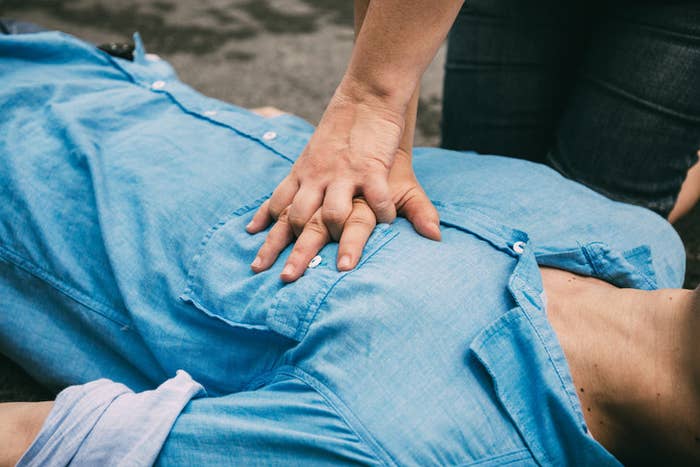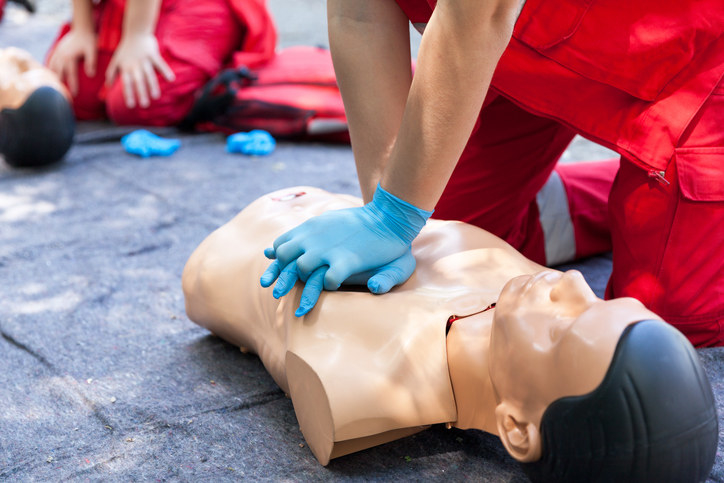CPR is a lifesaving emergency technique performed after a person's heartbeat or breathing has stopped.

Cardiopulmonary resuscitation, or CPR, involves giving chest compressions to someone in an emergency situation such as cardiac arrest, near-drowning, or suffocation.
The purpose of CPR is to maintain blood flow to the brain and other vital organs until the heart is shocked back into a normal rhythm by emergency medical responders or with an automatic defibrillator (AED). If someone collapses suddenly, you should start CPR immediately but at the same time ask someone else to call 911, then look for an AED. These can be found in malls, sports arenas, and a ton of other public places.
According to the American Heart Association (AHA), immediate CPR can double or triple chances of survival after cardiac arrest, usually by buying people time until an AED or ambulance arrives.
There's conventional CPR — for medical professionals and trained people — and hands-only CPR, which is for the general public. Conventional CPR involves chest compressions and mouth-to-mouth breaths given at a ratio of 30:2, respectively. Hands-only CPR involves giving chest compressions alone and that's a perfectly fine thing you can do as a bystander to help save someone's life.
We're talking about CPR for teens and adults here, because guidelines differ for small children and infants. (Full CPR steps can be found here.)
Even if you've been trained on how to do CPR, it can be tricky to perform compressions at the right pace — especially during an emergency.
Obviously, trying to do something is better than nothing — but there is a right way to perform CPR. You should place your hands, one over the other, on the center of the chest and press hard, and at the right rate. For adults, that's 100–120 compressions per minute given at a depth of at least 2 inches. But what does that even mean?
It's one thing to learn CPR, but it's another to remember the steps and perform it correctly when the time comes, especially if you're stressed or panicking.
Fortunately, there's an easy hack: Compress to the tempo of a song that's 100–120 beats per minute, such as "Stayin' Alive" by the Bee Gees or "Work It" by Missy Elliott.
You may not remember the exact rate for chest compressions, but you can probably remember how to sing or hum along to a crazy-popular song, right? Yes, we're talking about the same trick that Michael Scott uses in that infamous episode of The Office — but it really does work.
According to the AHA, research has shown that people are more likely to remember the correct pace when trained to give compressions to the beat of a familiar song.
It's not just "Stayin' Alive" and "Work It" — you can compress to the tempo of hits like "Dancing Queen" by ABBA, "MMMBop" by Hanson, and "Sorry" by Justin Bieber plus so many more. It doesn't matter if you're a baby boomer, millennial, or Gen Z — there's a song from your generation that matches the rate of CPR compressions.
One hospital even made a cool Spotify playlist full of songs — and there's A LOT of them — to help you perform CPR.
I learned how to do CPR today so now I know how to save your life but more importantly I found out New York Presbyterian Hospital maintains a Spotify playlist of songs that are the right beat to time CPR compressions to and it is on point https://t.co/C05BFPawBc
In a now-viral tweet, BuzzFeed News reporter Julia Reinstein wrote about finding a pretty amazing playlist from NewYork-Presbyterian Hospital full of songs with the right tempo for timing compressions.
Most of these songs are the same ones you'd want to jam out to with friends — seriously, I listened to the playlist while writing this article and it's full of bangers.
In all seriousness, CPR saves lives and everyone should learn how to do it if they can.

Check out the resources below to find a CPR class near you:
And here's AHA's video on how to do hands-only CPR.
